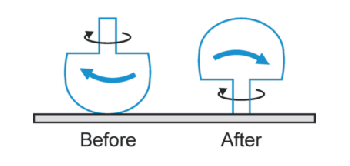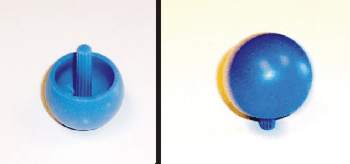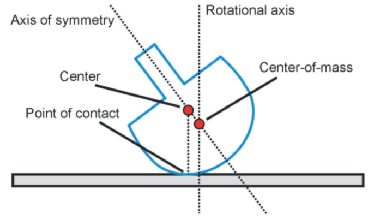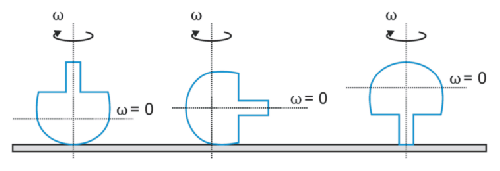 |
|
|
  
Demonstration no.: 79 Description: "The Tippe Top" (also known as "Tippetoppen" (Danish), "the inverting top","toupie magique", "topsy-turvy top" and in German "Stehaufkreisel" or "Wendekreisel") is a spinning top consisting of a section of a sphere fitted with a short, cylindrical rod ("the stem"). 
Close-up of a plastic tippe top. This model was produced at the Engineering College of Aarhus, Denmark.
When the Tippe Top is spun on a table, the top will quickly turn the stem down towards the table. When the stem touches the table, the top will invert and start spinning on the stem. This can be seen in the Quick Time movie found in the references. 
The Tippe Top is a spinning top, which will automatically lift its center of mass while it starts to turn in the opposite direction.
The interesting thing is that when the Tippe Top inverts, it also changes the direction of the rotation! In other words, at some point during the inversion, the top stops spinning around the axis through the stem and then starts to rotate the other way. At the same time, the center of mass is lifted, and the top is thus a quite interesting problem concerning conservation of energy and angular momentum. 
Left: Picture of Tippe Top at rest. Right: The top is spinning. Also watch the movie in the references.
If you do not have a real Tippe Top, the samme inversion effect can be achieved by spinning a hardboiled egg, an american football, or a round (oval) smooth stone. In the following, I will give a detailed description of the history of the Tippe Top, and I will also give a brief introduction to the theory of the top. HISTORY: The Tippe Top has been studied extensively for many years. Already in the 1800's, Sir William Thomson and professor Hugh Blackburn experimented by rotating eggshaped stones found on the beach. They saw properties similar to those of the Tippe Top, yet to be invented. A description of this story is found in a book by John Perry from 1890. In the same book (Figure 35), Perry describes a small spherical object with a center-of-mass which does not coincide with the center of the sphere. When the object is put on a table, it will point the center-of-mass down towards the table. Then the object is spun, and it lifts its center-of-mass just like a Tippe Top. In 1891, the top was patented as "Wendekreisel" in Germany by Helene Sperl from Munich. The patent ran out the year after because the patent fee was not paid (see the patent document in the references). Interestingly enough, none of the models described in the patent document appears to be working, according to Christian Ucke (Technical University in Munich, Germany), who has tried to build the tops described by Helene Sperl. The patent document does, however, describe the inversion property in words, so Sperl has properly had a fully functioning model, which just hasn't been described correctly in the document. According to Vendsyssel Historical Museum in Hjørring, Denmark, the Tippe Top was re-invented in 1950 by the Danish engineer Werner Østberg (who also named it "tippetop"). He got the idea during a visit to South America where he had seen local people playing with a small, round fruit. When they spun it by the stalk like an old-fashioned spinning top, it would spin for a second and then invert and spin on the stalk. The engineer mass-produced the Tippe Top, which quickly gained huge popularity all over the world. Werner Østberg also patented the top in several countries (e.g. British Patent no. 656540 - see the link in the references). In 1952 C.M. Braams of the Rijks University in Utrecht published articles about the Tippe Top, where he mentioned that the top was sold in The Netherlands at that time. In the article by J.A. Jacobs from Canada it says that "the top was first produced in Denmark and was later manufactured in Canada, being obtainable at any drug store or tobacconist for 25 cents". According to a website, the Tippe Top was sold in the UK by the British Indoors Pastimes Company from 1953, and in the middle of the 1950's, Tippe Tops could be found in cereal boxes like Post Rice Krinkles in the USA. According to Dan Goodsell from www.theimaginaryworld.com Tippe Tops could be found in cereal boxes from companies like Nabisco, General Mills and Post from the 1950's and up into the 1970's. 
Picture from around 1954 of two cereal boxes containing Tippe Tops. The picture is reproduced with permission from Dan Goodsell of www.theimaginaryworld.com.
A famous picture also exists from the opening of the institute of physics at the University of Lund in Sweden in 1951, where Wolfgang Pauli and Niels Bohr are looking at a Tippe Top. Bohr was very interested in the physics of the top, and it is believed that also Winston Churchill enjoyed the top. 
Picture of Wolfgang Pauli and Niels Bohr studying a Tippe Top. The picture is taken at the opening of the new institute of physics at the University of Lund on May 31 1951. Credit: Photograph by Erik Gustafson, courtesy AIP Emilio Segre Visual Archives, Margrethe Bohr Collection (www.aip.org/history/esva).
Halvard Baugerød from the town of Ås in Norway has written to Fysikbasen telling us that during a visit in 1962 to the Swedish centrifuge producer Alfa Laval in Tumba near Stockholm, he was given a tippetop with written explanation as a souvenir. Werner Østberg, who died in 1999, has left a scrapbook with newspaper articles about the Tippe Top. This scrapbook can be found today at the Vendsyssel Historical Museum in Denmark. In it can be seen several articles from Danish newspapers from 1951 and 1952 (see the references). Randolf Rehfeld from www.wundersamessammelsurium.de has sent Fysikbasen two German patents by an Oscar Hummel from 1948 and 1949. They describe to spinning tops quite similar to that of Østberg (see the references). What the connection between Hummel and Østberg is, is so far unknown. THEORY: The theory of the Tippe Top is quite complicated, but here I will give a brief qualitative summary based on the articles in the references. The popularity of the top grew rapidly all over the world during the 1950's, and several theoretical articles were published on the subject. To begin with, it was discussed whether sliding friction was important. Most authors believed that is was, and it was proven by Del Campo with a quite simple argument: Since the Tippe Top raises its center-of-mass, the top will have to get the necessary potential energy by spinning slower after inversion. This means that the angular momentum has been reduced, and this is only possible by applying an external torque, which again can only come from friction. The Tippe Top works because the center-of-mass does not coincide with the geometrical center of sphere. Since the rotational axis goes through the center-of-mass, the top will slide over the surface on which it is spinning: 
Since the geometrical center of the sphere does not coincide with the center-of-mass, the point of contact with the surface will not coincide with the rotational axis.

Since the point of contact does not coincide with the rotational axis, the Tippe Top will slide over the surface in a circle around the rotational axis. The sliding friction supplies the torque needed for the inversion of the top.
So, the top is influenced by friction and thus by a torque. This torque turns the stem from vertical and down towards the surface. If the surface was frictionless, the top would not work. As soon as the stem touches the surface, the top rises to spin on the stem. This is, again, caused by the torque from the friction. This can also happen for a normal spinning top, if the edge and the stem touches the surface simultaneously. Again, friction applies the necessary torque, and to increase this torque, the stem of a typical Tippe Top is normally grooved to increase friction between the stem and the surface, as can be seen on the picture at the top of this page. The rotation of the Tippe Top changes direction when it inverts. Because of this, the angular momentum maintains the same direction. When the top is started, it rotates around a vertical axis going through the stem. When the stem turns downwards, the rotation continues through a vertical axis. When the top is approximately horisontal, it will no longer rotate about the axis going through stem. The rotation about this axis starts up again - in the opposite direction - as the stem continues downwards. 
Rotational axes of a Tippe Top. When the top is almost (not completely) horisontal, the rotation around the stem will stop and start to rotate the other way.
To show that the top changed direction around the axis going through the stem, experiments were performed where the top was spun on a surface covered with carbon paper or sooted glass. This would draw a trace on the top, which showed how the Tippe Top changed rotational direction when the stem was nearly (but not completely) horisontal (see e.g. the articles by Pliskin from 1954 or Johnson from 1960). 
Diagram of carbon trace on a Tippe Top that has been spun on a piece of sooted glass or carbon paper.
ACKNOWLEDGEMENTS: The description of this experiment in Fysikbasen.dk has been made with the very valuable help of the following people: Anne Haubek (Danish National Television (DR)), Dr. Christian Ucke (Technische Universität München), Heather Lindsay (American Institute of Physics), Dan Goodsell (theimaginaryworld.com), Liv Vego (Department of Physics and Astronomy, University of Aarhus, Denmark), Ruth Hedegaard (Historical Museum of Vendsyssel, Hjørring, Denmark), and Randolf Rehfeld (www.wundersamessammelsurium.de). Equipment and materials:
References:
PIRA DCS: 1Q60.30 (Mechanics: Rotational dynamics) Updated: 26 December 2007 If you have comments, corrections or suggestions regarding this demonstration, |
| FYSIKBASEN.DK was updated on Sunday, 16 June 2008, at 23:01. |
 The Tippe Top
The Tippe Top Tippe Top
Tippe Top